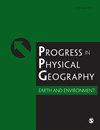Problems and prospects of portmanteau titles and other neologisms for interface disciplines in the Earth and life sciences
IF 3.6
3区 地球科学
Q2 GEOGRAPHY, PHYSICAL
Progress in Physical Geography-Earth and Environment
Pub Date : 2024-06-22
DOI:10.1177/03091333241263859
引用次数: 0
Abstract
The Earth and life sciences are replete with portmanteau (blended) words and neologisms. Researchers at the interfaces between the traditional disciplines within the Earth and life sciences have coined dual titles for ‘new’ disciplines, such as geobiology/biogeology and ecohydrology/hydroecology. An upsurge in such coinage over the last few decades reflects a healthy willingness of many researchers to cross traditional disciplinary boundaries and to include the human sphere within their domains. However, some of the titles cause confusion because their meanings are not self-evident; rather, they sometimes demand extra research to reveal their meanings, thus rendering science less ‘open’ at a time when Open Science is being vigorously encouraged. After discussing the question of disciplinary neologisms, the paper probes the interchangeability of 15 dual ‘new’ discipline titles and concludes that six are more-or-less synonymous, three are nonsynonymous, and six are indeterminate for varying reasons. We question the usefulness of some, but by no means all, disciplinary neologisms, given that their meanings are not immediately apparent. Looking beyond portmanteau titles and other neologisms, the paper discusses the rise of interdisciplinary and transdisciplinary research, as seen in the concepts of the Critical Zone, multifunctional landscapes, and Earth System Science, the last of which supports a conceptual model of the planet as an interdependent set of spheres from global to local scales that has the advantages of combining the biotic, abiotic, and human spheres.地球科学和生命科学界面学科的联名标题和其他新词的问题与前景
地球科学和生命科学中充斥着许多联名词(混合词)和新词。地球科学和生命科学传统学科之间的研究人员为 "新 "学科创造了双重名称,如地球生物学/生物地质学和生态水文学/水生态学。在过去的几十年中,此类命名的激增反映出许多研究人员愿意跨越传统学科的界限,将人类领域纳入其研究领域。然而,有些名称会引起混淆,因为它们的含义并不是不言自明的;相反,它们有时需要额外的研究才能揭示其含义,从而在大力鼓励开放科学的今天使科学变得不那么 "开放"。在讨论了学科新名称的问题之后,本文对 15 个双重 "新 "学科名称的互换性进行了探究,并得出结论:6 个基本同义,3 个非同义,6 个因不同原因而不确定。我们质疑一些学科新名称的实用性,但绝非所有学科新名称,因为它们的含义并非一目了然。除了联名标题和其他新名词之外,本文还讨论了跨学科和跨学科研究的兴起,如 "临界区"、"多功能景观 "和 "地球系统科学 "等概念,其中 "临界区 "和 "多功能景观 "支持将地球作为从全球到地方尺度的一系列相互依存的领域的概念模型,而 "地球系统科学 "则具有将生物、非生物和人类领域相结合的优势。
本文章由计算机程序翻译,如有差异,请以英文原文为准。
求助全文
约1分钟内获得全文
求助全文
来源期刊
CiteScore
7.20
自引率
5.10%
发文量
53
审稿时长
>12 weeks
期刊介绍:
Progress in Physical Geography is a peer-reviewed, international journal, encompassing an interdisciplinary approach incorporating the latest developments and debates within Physical Geography and interrelated fields across the Earth, Biological and Ecological System Sciences.

 求助内容:
求助内容: 应助结果提醒方式:
应助结果提醒方式:


